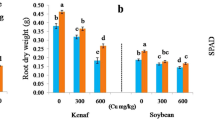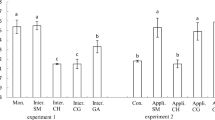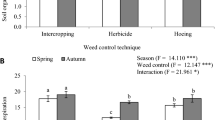Abstract
Intercropping is considered a sustainable agricultural practice that can reduce the environmental impacts on agriculture. Our study investigated the morphology, physiology, and cadmium (Cd) and lead (Pb) uptake of kenaf (Hibiscus cannabinus L.) and soybean (Glycine max L.) under intercropping in mining soil. Results showed that mutual intercropping is conducive to the growth and biomass accumulation of kenaf and soybean, compared to their respective monoculture. Intercropping increased the relative chlorophyll index in kenaf, while that in soybean had no significant effect. Furthermore, intercropping increased the antioxidant enzyme activity of kenaf, while that of soybean reduced or had no significant effect. The content of malondialdehyde (MDA) was decreased in both of the species. Compared to their respective monoculture, Cd content was increased in kenaf leaves and reduced in soybean roots. Moreover, intercropping decreased the Pb content in tissues of both the species, except that Pb content of kenaf roots was increased. At the same time, root, leaf, or stem bioconcentration factors also performed the same trend, and TF was less than 1. These results indicated that intercropping can increase the plant growth and decrease the metal content in plant tissues. Present findings could provide support for future research on kenaf and soybean cultivation in contaminated lands. In addition, the present study strengthens our understanding about the effectiveness of intercropping system on heavy metal–contaminated lands for sustainable agricultural production.








Similar content being viewed by others
Data availability
All data generated or analyzed during this study are included in this article.
References
Adeyemi NO, Atayese MO, Olubode AA, Akan ME (2020) Effect of commercial arbuscular mycorrhizal fungi inoculant on growth and yield of soybean under controlled and natural field conditions. J Plant Nutr 43:487–499
Adeyemi NO, Atayese MO, Sakariyawo OS, Azeez JO, Sobowale SPA, Olubode A, Adeoye S (2021) Alleviation of heavy metal stress by arbuscular mycorrhizal symbiosis in Glycine max (L.) grown in copper, lead and zinc contaminated soils. Rhizosphere-Neth 18:100325
Alamri SA, Siddiqui MH, Al-Khaishany MYY, Khan MN, Ali HM, Alaraidh IA, Alsahli AA, Al-Rabiah H, Mateen M (2018) Ascorbic acid improves the tolerance of wheat plants to lead toxicity. J Plant Interact 13:409–419
Ali H, Khan V, Sajad MA (2013) Phytoremediation of heavy metals-concepts and applications. Chemosphere 91:869–881
Alsafran M, Usman K, Ahmed B, Rizwan M, Saleem MH, Jabri HA (2022) Understanding the phytoremediation mechanisms of potentially toxic elements: a proteomic overview of recent advances. Front Plant Sci 13. https://doi.org/10.3389/fpls.2022.881242
Arbaoui S, Evlard A, Mhamdi MW, Campanella B, Paul R, Bettaieb T (2013) Potential of kenaf (Hibiscus cannabinus L.) and corn (Zea mays L.) for phytoremediation of dredging sludge contaminated by trace metals. Biodegradation 24:563–567
Ashraf S, Ali Q, Zahir ZA, Ashraf S, Asghar HN (2019) Phytoremediation: environmentally sustainable way for reclamation of heavy metal polluted soils. Ecotoxicol Environ Saf 174:714–727
Bali AS, Sidhu GPS, Kumar V (2020) Root exudates ameliorate cadmium tolerance in plants: a review. Environ Chem Lett 18:1243–1275. https://doi.org/10.1007/s10311-020-01012-x
Berni R, Luyckx M, Xu X, Legay S, Sergeant K, Hausman JF, Lutts S, Cai G, Gea G (2019) Reactive oxygen species and heavy metal stress in plants: impact on the cell wall and secondary metabolism. Environ Exp Bot 161:98–106
Bruce EP (2001) Phytoremediation of contaminated soil and groundwater at hazardous waste sizes. EPA 540:01–500
Budi S, Cholid M (2018) Do new varieties of maize and kenaf could improve growth and production when cultivated by intercropping in seasonal flooded area of Bonorowo land? RJOAS 8:80
Cahill JF, McNickle GG, Haag JJ, Lamb EG, Nyanumba SM, St Clair CC (2010) Plants integrate information about nutrients and neighbors. Science 328:1657
Carranca C, Torres MO, Madeira M (2015) Underestimated role of legume roots for soil N fertility. Agron Sustain Dev 35:1095–1102
Cataldo DA, Wildung RE (1978) Soil and plant factors influencing the accumulation of heavy metals by plants. Environ Health Perspect. https://doi.org/10.1289/ehp.7827149
Chai YN, Schachtman DP (2022) Root exudates impact plant performance under abiotic stress. Trends Plant Sci 27:80–91. https://doi.org/10.1016/j.tplants.2021.08.003
Chamkhi I, Cheto S, Geistlinger J, Zeroual Y, Kouisni L, Bargaz A, Ghoulam C (2022) Legume-based intercropping systems promote beneficial rhizobacterial community and crop yield under stressing conditions. Ind Crops Prod 183:114958. https://doi.org/10.1016/j.indcrop.2022.114958
Chen P, Chen T, Li ZQ, Jia RX, Luo DJ, Tang MQ, Lu H, Hu YL, Yue J, Huang Z (2020) Transcriptome analysis revealed key genes and pathways related to cadmium-stress tolerance in Kenaf (Hibiscus cannabinus L.). Ind Crop Prod 158:112970
Chen P, Li Z, Luo D, Jia R, Lu H, Tang M, Hu Y, Yue J, Huang Z (2021) Comparative transcriptomic analysis reveals key genes and pathways in two different cadmium tolerance kenaf (Hibiscus cannabinus L.) cultivars. Chemosphere 263:128211
Cheng SF, Huang CY (2007) Accumulation of cadmium uptake from soil in the edible root of root vegetables. J Environ Eng Manag 17:137
Choppala G, Saifullah N, Bolan S, Bibi M, Iqbal Z, Rengel A, Kunhikrishnan N, Ashwath YS (2014) Cellular mechanisms in higher plants governing tolerance to cadmium toxicity. Crit Rev Plant Sci 33:374–391
Cojocaru P, Gusiatin ZM, Cretescu I (2016) Phytoextraction of Cd and Zn as single or mixed pollutants from soil by rape (Brassica napus). Environ Sci Pollut Control Ser 23:10693–10701
Cui T, Fang L, Wang M, Jiang M, Shen GT (2018) Intercropping of gramineous pasture ryegrass (Lolium perenne L.) and leguminous forage alfalfa (Medicago sativa L.) increases the resistance of plants to heavy metals. J Chem 7:1–11
Curtright AJ, Tiemann LK (2021) Meta-analysis dataset of soil extracellular enzyme activities in intercropping systems. Data Brief 38:107284
de Kroon H, Hendriks M, van Ruijven J, Ravenek J, Padilla FM, Jongejans E, Visser EJW, Mommer L (2012) Root responses to nutrients and soil biota: drivers of species coexistence and ecosystem productivity. J Ecol 100:6–15
Dias MC, Mariz-Pontec N, Santosc C (2019) Lead induces oxidative stress in Pisum sativum plants and changes the levels of phytohormones with antioxidant role. Plant Physiol Biochem 137:121–129
Garbisu C, Hernández-Allica J, Barrutia O, Alkorta I, Becerril JM (2002) Phytoremediation: a technology using green plants to remove contaminants from polluted areas. Rev Environ Health 17:173–188. https://doi.org/10.1515/reveh.2002.17.3.173. (PMID: 12462482)
Gavrilescu M (2022) Enhancing phytoremediation of soils polluted with heavy metals. Curr Opin Biotechnol 74:21–31
Guo Y, Xiao Q, Zhao X, Wu Z, Dai Z, Zhang M, Qiu C, Long S, Wang Y (2023) Phytoremediation with kenaf (Hibiscus cannabinus L.) for cadmium-contaminated paddy soil in southern China: translocation, uptake, and assessment of cultivars. Environ Sci Pollut Res Int 30:1244–1252
Hasanuzzaman M, Bhuyan MHMB, Zulfiqar F, Raza A, Mohsin SM, Al Mahmud J, Fujita M, Fotopoulos V (2020) Reactive oxygen species and antioxidant defense in plants under abiotic stress: revisiting the crucial role of a universal defense regulator. Antioxidants (basel) 9:681
Hauggaard-Nielsen H, Ambus P, Jensen ES (2001) Temporal and spatial distribution of roots and competition for nitrogen in pea-barley intercrops - a field study employing 32P technique. Plant Soil 236:63–74
Hermans C, Hammond JP, White PJ, Verbruggen N (2006) How do plants respond to nutrient shortage by biomass allocation? Trends Plant Sci 11:610–617
Hermans C, Chen J, Coppens F, Inzé D, Verbruggen N (2011) Low magnesium status in plants enhances tolerance to cadmium exposure. New Phytol 192:428–436
Huang X, Jiang Y, Cheng X, Deng L, Liu X (2015) Photosynthetic performance and anti-oxidative response of Cornus controversa seedlings under cadmium and lead stress. Bangladesh J Bot 44:215–221
Inal A, Gunes A, Yhang F, Cakmak I (2007) Peanut/maize intercropping induced changes in rhizosphere and nutrient concentrations in shoots. Plant Physiol Biochem 45:350–356
Jali P, Pradhan C, Das AB (2016) Effects of cadmium toxicity in plants: a review article. Sch Acad J Biosci 4:1074–1081
Jurik TW, Van K (2004) Microenvironment of a corn-soybean-oat strip intercrop system. Field Crop Res 90:335–349
Khan S, Rehman S, Khan AZ, Khan MA, Shah MT (2010) Soils and vegetables enrichment with heavy metals from geological sources in Gilgit, northern Pakistan. Ecotoxicol Environ Saf 73:1820–1827
Knörzer H, Graeff-Hönninger S, Guo B, Wang P, Claupein W (2009) The rediscovery of intercropping in China: a traditional cropping system for future Chinese agriculture – a review. https://doi.org/10.1007/978-90-481-2716-0_3
Kohli SK, Neha H, Vandana G, Shagun B, Anket S, Kanika K, Saroj A, Kumar TA, Puja O, Victorovich KY, Evgenovich KY, Bhardwaj R (2017) ROS signaling in plants under heavy metal stress. Reactive oxygen species and antioxidant systems in plants: role and regulation under abiotic stress. Springer, Singapore, pp 185–214
Li L, Sun J, Zhang F, Li XL, Rengel Z, Yan SC (2001) Wheat/maize or wheat/soybean strip intercropping II. Recovery or compensation of maize and soybean after wheat harvesting. F Crop Res 71:173–181
Li CY, He XH, Zhu SS, Zhou H, Wang Y, Li Y et al (2009) Crop diversity for yield increase. PLoS One 4:e8049
Li C, Dong Y, Li H, Shen J, Zhang F (2014) The dynamic process of interspecific interactions of competitive nitrogen capture between intercropped wheat (Triticum aestivum L) and faba bean (Vicia faba L.). PLoS One 9:e115804
Liebman M, Dyck E (1993) Crop rotation and intercropping strategies for weed management. Ecol Appl 3:92–122
Lin LJ, Jin Q, Liu YJ, Ning B, Liao MA, Luo L (2014) Screening of a new cadmium hyperaccumulator, Galinsoga Parviflora, from winter farmland weeds using the artificially high soil cadmium concentration method. Environ Toxicol Chem 33:2422–2428
Lu Q, Li J, Chen F, Liao M, Lin L, Tang Y, Liang D, Xia H, Lai Y, Wang X, Chen C, Ren W (2017) Effects of mutual intercropping on the cadmium accumulation in accumulator plants Stellaria media, Malachium aquaticum, and Galium aparine. Environ Monit Assess 189:622
Marques APGC, Range AOSS, Castro PML (2009) Remediation of heavy metal contaminated soils: phytoremediation as a potentially promising clean-up technology. Crit Rev Environ Sci Technol 39:622–654
Marrugo-Negrete J, Pinedo-Hernandez J, Diez S (2017) Assessment of heavy metal pollution, spatial distribution and origin in agricultural soils along the Sinu River Basin, Colombia. Environ Res 154:380–388
Muhammad S, Shah MT, Khan S (2011) Health risk assessment of heavy metals and their source apportionment in drinking water of Kohistan region, northern Pakistan. Microchem J 98:334–343
Naila A, Meerdink G, Jayasena V, Sulaiman AZ, Ajit AB, Berta G (2019) A review on global metal accumulators-mechanism, enhancement, commercial application, and research trend. Environ Sci Pollut Res 26:26449–26471
Niazy M (2015) Phytoremediation: a role of kenaf plants (Hibiscus cannabinus L.) in the remediation of cadmium contaminated water. J Biol Chem Environ Sci 10:167–181
Pan S, Lu R, Li H, Lin LJ, Li LP, Xiang J, Chen L, Tang YW (2021) Effects of mutual intercropping on cadmium accumulation in seedlings of three varieties of eggplant. Int J Environ Anal Chem 101:1761–1772
Pan J, Cao S, Xu G, Rehman M, Xin L, Luo D, Wang C, Fang W, Xiao H, Liao C, Chen P (2023) Comprehensive analysis reveals the underlying mechanism of arbuscular mycorrhizal fungi in kenaf cadmium stress alleviation. Chemosphere 314:137566
Pinto FR, Mourato MP, Sales JR, Moreira IN, Martins LL (2017) Oxidative stress response in spinach plants induced by cadmium. J Plant Nutr 40:268–276
Pourrut B, Shahid M, Dumat C, Winterton P, Pinelli E (2011) Lead uptake, toxicity, and detoxification in plants. Rev Environ Contam Toxicol 213:113–136
Qin G, Niu Z, Yu J, Li Z, Ma J, Xiang P (2021) Soil heavy metal pollution and food safety in China: effects, sources and removing technology. Chemosphere 267:129205. https://doi.org/10.1016/j.chemosphere.2020.129205
Qiu JJ, Song XW, Li SS, Zhu BH, Chen YT, Zhang L, Li Z (2021) Experimental and modeling studies of competitive Pb and Cd bioaccumulation by Aspergillus niger. Appl Microbiol Biotechnol 105:6477–6488
Rehman M, Maqbool Z, Peng D, Liu L (2019) Morpho-physiological traits, antioxidant capacity and phytoextraction of copper by ramie (Boehmeria nivea L.) grown as fodder in copper-contaminated soil. Environ Sci Pollut Res 26:5851e5861
Rehman M, Saleem MH, Fahad S, Maqbool Z, Peng D, Deng G, Liu L (2021) Medium nitrogen optimized Boehmeria nivea L. growth in copper contaminated soil. Chemosphere 266:128972
Rerkasem B, Rerkasem K, Peoples MB, Herridge DF, Bergersen FJ (1988) Measurement of N2 fixation in maize (Zea mays L.) – ricebean (Vigna umbellata [Thunb.] Ohwi and Ohashi) intercrops. Plant Soil 108:125–135
Saleem MH, Fahad S, Rehman M, Saud S, Jamal Y, Khan S, Liu L (2020) Morpho-physiological traits, biochemical response and phytoextraction potential of short-term copper stress on kenaf (Hibiscus cannabinus L.) seedlings. PeerJ 8:e8321
Silvertown JW, Charlesworth D (2001) Introduction to plant population biology. Blackwell Science, Oxford
Sun LL, Dong X, Wang Y, Maker G, Agarwal M, Ding Z (2022) Tea-soybean intercropping improves tea quality and nutrition uptake by inducing changes of rhizosphere bacterial communities. Microorganisms 10:2149
Suresh B, Ravishankar GA (2004) Phytoremediation–a novel and promising approach for environmental clean-up. Crit Rev Biotechnol 24:97–124. https://doi.org/10.1080/07388550490493627
Tang Y, He J, Yu X, Xie Y, Lin L, Sun G, Li H, Liao M, Liang D, Xia H, Wang S, Zhang J, Liu Z, Tu L, Liu L (2017) Intercropping with solanum nigrum and solanum photeinocarpum from two ecoclimatic regions promotes growth and reduces cadmium uptake of eggplant seedlings. Pedosphere 27:638–644
Tang W, Tang W, Xie Y, Li X, Li H, Lin L, Huang Z, Sun B, Sun G, Tu L, Tang Y (2022) Effects of intercropping on Se accumulation and growth of pakchoi, lettuce and radish. Int J Phytoremediation 4:1–8
Vance CP (1998) Legume symbiotic nitrogen fixation: agronomic aspects. In: Spaink HP et al (eds) The Rhizobiaceae. Kluwer Academic Publishers, Dordrecht, pp 509–530
Vergara Cid C, Pignata ML, Rodriguez JH (2020) Effects of co-cropping on soybean growth and stress response in lead-polluted soils. Chemosphere 246:125833
Wang J, Lu X, Zhang J, Ouyang Y, Wei G, Xiong Y (2020) Rice intercropping with alligator flag (Thalia dealbata): a novel model to produce safe cereal grains while remediating cadmium contaminated paddy soil. J Hazard Mater 394:122505
Wang T, Zhang L, Li S, Meng L, Su M, Wang Z, Nong Y, Sun Y, Wang S, Li Z (2022a) Weakened Cd toxicity to fungi under coexistence of Pb in solution. J Hazard Mater 426:127984
Wang Y, Zhang Y, Zhang H, Yang Z, Zhu Q, Yan B, Fei J, Rong X, Peng J, Luo G (2022b) Intercropping-driven nitrogen trade-off enhances maize productivity in a long-term experiment. Field Crops Res 287:108671. https://doi.org/10.1016/j.fcr.2022.108671
Wei K, Wang L, Zhou J, He W, Zeng J, Jiang Y, Cheng H (2011) Catechin contents in tea (Camellia sinensis) as affected by cultivar and environment and their relation to chlorophyll contents. Food Chem 125:44–48
Whiting SN, Leake JR, McGrath SP, Baker AJ (2001) Hyperaccumulation of Zn by Thlaspi caerulescens can ameliorate Zn toxicity in the rhizosphere of cocropped Thlaspi arvense. Environ Sci Technol 35:3237–3241
Xie Y, Wang L, Yang L, Yan WY, He ZQ, Tang Y, Liao MA, Zhou XT (2021) Intercropping with Eclipta prostrata and Crassocephalum crepidioides decrease cadmium uptake of tomato seedlings. Int J Environ Anal Chem 101:1231–1239
Xu Z, Zhou Q, Liu W (2009) Joint effects of cadmium and lead on seedlings of four Chinese cabbage cultivars in northeastern China. J Environ Sci 21:1598–1606
Yan A, Wang Y, Tan SN, Yusof MLM, Ghosh S, Chen Z (2020) Phytoremediation: a promising approach for revegetation of heavy metal-polluted land. Front Plant Sci 11. https://doi.org/10.3389/fpls.2020.00359
Zand AD, Nabibidhendi G, Mehrdadi N, Shirdam R, Tabrizi AM (2010) Total petroleum hydrocarbon (TPHs) dissipation through rhizoremediation by plant species. Pol J Environ Stud 19:115–122
Zeng P, Guo ZH, Xiao XY, Peng C, Huang B (2018) Intercropping Arundo donax with woody plants to remediate heavy metal-contaminated Soil. Huan Jing Ke Xue 39:5207–5216 ((in Chinese))
Zhu H, Chen L, Xing W, Ran S, Wei Z, Amee M, Wassie M, Niu H, Tang D, Sun J, Du D, Yao J, Hou H, Chen K, Sun J (2020) Phytohormones-induced senescence efficiently promotes the transport of cadmium from roots into shoots of plants: a novel strategy for strengthening of phytoremediation. J Hazard Mater 388:122080
Zuo YM, Li XL, Cao YP, Zhang FS, Christie P (2003) Iron nutrition of peanut enhanced by mixed cropping with maize: Possible role of root morphology and rhizosphere microflora. J Plant Nutr 26(10–11):2093–2110
Funding
This study was supported by a grant from “The National Natural Science Foundation of China” (31960368).
Author information
Authors and Affiliations
Contributions
The experiment was designed by Peng Chen. Material preparation was done by Muzammal Rehman, Jiao Pan, and Wenyue Ma. Data collection, data analysis, and write up of the first draft of the manuscript were done by Muzammal Rehman. Manuscript was revised by Peng Chen, Samavia Mubeen, Dengjie Luo, and Shan Cao. All authors read and approved the final manuscript.
Corresponding author
Ethics declarations
Ethics approval and consent to participate
Not applicable.
Consent for publication
Not applicable.
Competing interests
The authors declare no competing interests.
Additional information
Responsible Editor: Elena Maestri
Publisher's note
Springer Nature remains neutral with regard to jurisdictional claims in published maps and institutional affiliations.
Rights and permissions
Springer Nature or its licensor (e.g. a society or other partner) holds exclusive rights to this article under a publishing agreement with the author(s) or other rightsholder(s); author self-archiving of the accepted manuscript version of this article is solely governed by the terms of such publishing agreement and applicable law.
About this article
Cite this article
Rehman, M., Pan, J., Mubeen, S. et al. Intercropping of kenaf and soybean affects plant growth, antioxidant capacity, and uptake of cadmium and lead in contaminated mining soil. Environ Sci Pollut Res 30, 89638–89650 (2023). https://doi.org/10.1007/s11356-023-28757-6
Received:
Accepted:
Published:
Issue Date:
DOI: https://doi.org/10.1007/s11356-023-28757-6




